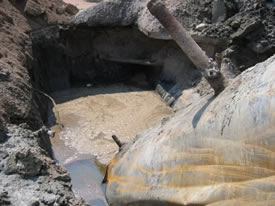Share:
OVERVIEW

An underground storage tank system (UST) is a tank and any underground piping connected to the tank that has at least 10 percent of its combined volume underground. UST systems that contain fuels, chemicals, and wastes are numerous and widespread and pose a significant threat to ground water quality in the United States. Currently, there are more than 640,000 federally regulated active USTs that store fuels or hazardous substances. These systems can and do leak, and when they leak they contaminate soil and ground water—even hydrologically connected surface water. These leaks often occur in populated areas, where public and domestic water supplies are concentrated, and it is difficult and expensive to clean them up, particularly if they involve a public source of drinking water.
Since 1985, federal and state UST programs have significantly reduced the risk of new releases by implementing release prevention and leak-detection requirements and establishing improved design, installation, and operational technical standards. Federal and state leaking underground storage tank (LUST) programs have overseen the cleanup of nearly 351,000 leaking tank sites. At the same time, states have had to respond to new contamination problems from fuel constituents such as methyl tert-butyl ether (MTBE). The continued widespread use of UST systems (including large numbers of heating fuel storage tanks that are not federally regulated) requires that existing regulations be fully enforced and that additional regulatory, land-use, and engineering measures be developed and fully implemented to further minimize threats to public health and safety, the economy, and the environment.
WHY USTS MATTER TO GROUNDWATER
USTs continue to be a big deal because each installation has the potential to leak, threatening human health and the environment. Leaked product contaminates groundwater used for drinking and other uses and, on occasion, enters surface water. Today’s improved UST systems are the product of federal and state requirements and programs, as well as improved technologies and a heightened awareness on the part of tank owners and operators. However, leaks still occur, albeit far less frequently, and we must stay vigilant in order to prevent tank systems from leaking in the first place and to ensure that leaking systems are reported immediately and cleaned up expeditiously.
From the Ground Water Report to the Nation
Underground Storage Tanks – Summary Sheet : Full Chapter